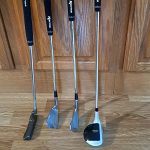Choosing the right golf club length for junior players is vital for developing proper swing mechanics and ensuring an enjoyable experience. Kids need specially designed equipment, considering their height, arm length, and playing ability.
Manufacturers’ size charts and adjustable clubs can help match clubs to a child’s measurements, aiding posture and control and reducing bad habits.
Regularly reassessing equipment as the child grows is crucial for ongoing comfort and performance improvement.
Junior golfers need to maximize their potential and foster a lifelong passion for golf. Using age-appropriate clubs also helps prevent injuries that can arise from using incorrectly sized equipment.
Investing in quality junior golf clubs can set a strong foundation for future success in the sport. Parents should also consider the material and weight of junior golf clubs.
Lighter clubs made from graphite shafts, for example, can make it easier for kids to handle and swing them properly.
Importance of Proper Junior Golf Club Length
Selecting the correct junior golf club length is crucial for young golfers’ performance, as improperly sized clubs can disrupt swing mechanics and create poor habits.
Properly sized clubs enhance consistency, control, and confidence, making it easier for juniors to make solid contact and enjoy the game. Correct club length also prevents physical strain, promoting a healthier golfing experience.
Using well-fitted clubs helps juniors focus on technique and skill growth, accelerating their development and success.
Parents and coaches should measure juniors accurately and consider adjustable clubs to ensure an optimal fit as the child grows, supporting their long-term enjoyment and skill enhancement in golf.
Factors to Consider When Sizing Junior Golf Clubs
Choosing the right junior golf club length involves several factors that influence performance and comfort. Addressing these variables ensures juniors develop proper technique and enjoy the game.
Height and Age
Height and age directly affect the size of junior golf clubs, with taller juniors needing longer clubs and shorter juniors benefiting from shorter ones. For instance, a child around 54 inches tall might need clubs about 36 inches long.
Age offers a general guideline, but individual height and growth spurts may necessitate adjustments.
Measuring the junior golfer for the best fit is crucial, and manufacturers often provide size charts to help select the right length. Properly fitting clubs enhance performance and reduce the risk of injury.
Skill Level and Swing Speed
Skill level and swing speed are pivotal in selecting appropriate club length. Advanced juniors with faster swing speeds often require longer clubs to maximize distance and control.
Conversely, beginners benefit from shorter, manageable clubs that help refine technique. Monitoring swing speed helps ensure clubs match the player’s capabilities.
In addition, regular assessments and adjustments are crucial as junior golfers grow. Consulting with a professional can provide personalized recommendations, ensuring optimal development and performance on the course.
Club Weight and Balance
Club weight and balance are crucial in selecting junior golf clubs. Lighter clubs are easier for juniors to handle, improving swing mechanics and reducing fatigue.
Balanced clubs, with evenly distributed weight, help achieve consistent swings. The right combination of weight and balance enhances control and overall performance.
Additionally, the length of the club must match the player’s height and arm length, as improperly sized clubs can hinder proper swing mechanics and posture. Properly fitted clubs ensure better posture and more effective training.
How to Measure Junior Golf Club Length
To measure junior golf club length accurately, have the golfer stand upright without shoes and with arms relaxed at their sides. Measure their height from the ground to the top of their head.
Use a height-to-club length chart specific to the club manufacturer for the recommended length. If no chart is available, measure existing clubs on a flat surface from the heel to the end of the grip and adjust for arm length and posture as needed.
A swing test with different club lengths can help confirm a natural and comfortable fit. Accurate measurements enhance performance and enjoyment in golfing.
Guide to Junior Golf Club Sizes by Age Group
Choosing the right golf club size for juniors significantly impacts their performance and enjoyment on the course. This guide categorizes junior golf club sizes based on age groups.
Ages 2-5
For juniors aged 2-5, shorter clubs are essential. These clubs, typically 18-23 inches long, match the height and strength of young golfers. Lightweight clubs offer better control, helping kids develop proper swing mechanics.
Manufacturers often group clubs in sets tailored for this age range, ensuring an ideal fit. As children grow, their club needs will change.
For kids aged 6-9, clubs between 24-27 inches are more suitable. These clubs are designed to promote confidence and facilitate better skill development.
Ages 6-8
Clubs for 6-8-year-olds typically measure between 24-28 inches, with lightweight materials like graphite recommended for easier handling and better swing speed. Beginner sets usually include multiple clubs for various situations.
It’s crucial to regularly assess the child’s growth to ensure proper club length, as incorrect sizing can hinder development and lead to poor swing mechanics.
Investing in adjustable clubs or replacing them as the child grows enhances performance and enjoyment of the game.
Ages 9-12
Juniors aged 9-12 typically use clubs 29-34 inches long. These clubs suit their greater height and improved strength. Junior golf sets in this age group often include a mixture of woods, irons, and putters, supporting skill development across various aspects of the game.
Adjustments may be needed based on individual growth spurts and skill advancements. It’s crucial to measure the child’s height and arm length to ensure proper fit.
Custom fitting sessions can provide even more precise adjustments, enhancing comfort and performance on the course.
Ages 13-14
Golf clubs for ages 13-14 usually range between 34-38 inches. Growth and increased prowess necessitate longer and more advanced clubs.
This age group often transitions to lighter adult clubs, modified for junior use. Sets frequently include higher-lofted woods and a combination of mid to short irons, enhancing playability and control.
Selecting age-appropriate clubs ensures juniors can play effectively and enjoyably, fostering better skill development and a lifelong passion for golf.
Custom Fitting vs. Standard Golf Clubs
Choosing the right junior golf club length involves deciding between custom fitting and standard golf clubs. Custom fitting tailors clubs to the junior’s height, swing speed, and skill level, enhancing performance and accommodating growth, which is ideal for serious players.
Standard golf clubs are a cost-effective solution with predetermined sizes for specific age groups, suitable for beginners.
The decision depends on the player’s commitment and budget, balancing these factors for optimal performance and enjoyment.
Understanding the pros and cons of each option helps parents make an informed decision that best supports their child’s development in the sport.
Frequently Asked Questions
What is the difference between junior and adult golf clubs?
Junior golf clubs are shorter and lighter with more flexible shafts designed for younger players. These features accommodate their physical attributes and swing speeds, making it easier for juniors to handle and swing effectively.
Is it better to have shorter or longer golf clubs?
The ideal club length depends on the player’s swing speed. Faster swing speeds benefit from longer clubs for added distance, while slower swing speeds may require shorter clubs for better control and solid contact.
What golf clubs does a junior need?
Junior golfers typically need a driver, fairway wood, 7 irons, a pitching wedge, sand wedge, a putter, and a golf bag. As they grow and improve, they may need a full set, especially around ages 12-13.
Can you cut down adult golf clubs for kids?
Cutting down adult clubs for juniors often leads to poor performance as the stiffness and balance of the club are affected. It’s better to use clubs specifically designed for junior players.
What is the length of junior golf clubs?
The length of junior golf clubs varies based on age and height. For accurate sizing, measure the player’s height and consult manufacturer size charts to select the appropriate length for optimal performance.
Conclusion
Choosing the right length of golf clubs for junior players is crucial for their development and love for the sport.
Custom-fitted clubs offer personalized solutions that enhance performance, which are ideal for serious young golfers, while standard clubs are more cost-effective and suitable for beginners.
Periodic assessments of the player’s height and swing are essential to ensure the clubs remain appropriate, preventing bad habits and injuries. Investing in the correct club length promotes proper technique and increases enjoyment in the game.
Seeking professional advice is recommended to ensure each junior golfer maximizes their equipment’s potential. Local golf shops or coaches can provide measurements and recommendations tailored to the junior player’s needs.
Additionally, regular upgrades as the child grows can sustain their interest and skill progression. Being proactive about these changes not only supports physical growth but also keeps them engaged and motivated.








Colin McCarthy